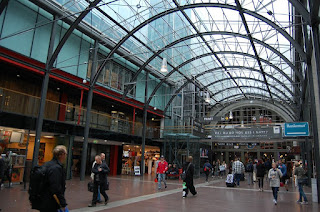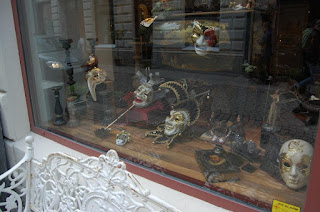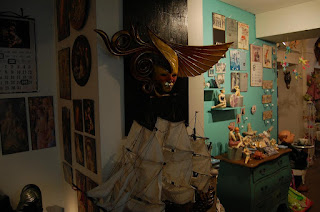Vandaag maakte ik een stadswandeling. De tekst op de blogg is te lezen in de brochure van het toeristen kantoor. Ik ben het helemaal met hen eens, dus wat kan ik beter doen dan hen citeren. Ik hoop dat je een impressie krijgt door mijn foto’s.
Today I had a city walk. The following text from the Göteborg tourist information, I find very appropriate. I therefore agree with them. So what can I do better than quote them? With my photographs I hope to give you an impression.
Today I had a city walk. The following text from the Göteborg tourist information, I find very appropriate. I therefore agree with them. So what can I do better than quote them? With my photographs I hope to give you an impression.
_____________________________________________________________________
Welcome to Göteborg.
Göteborg, Gothenburg, Gotemburgo, Gothembourg, Gautaburg or Gotenburg. As the Swedish expression says: “Kärt barn har mänga namn” (A loved child has many names.) In Göteborg’s case it is a clear signal: this is a city that is open to foreign influences and has always been open to the world.
Göteborg is not located inland or hidden in a bay. The Atlantic salty waves dash against the rocks of the archipelago outside the harbour entrance. Historically the city has functioned as Sweden’s international gateway, where raw materials and exotic produce were unloaded on the wharves and foreign cultures and customs first set food on Swedish soil.
Looking back to the foundation of the city in 1621, Göteborg’s first officially registered citizen was the Dutchman Johan van Lingen. His fellow-countrymen used town planning concepts from Amsterdam and Java to give Göteborg its classic design, with straight streets, rectangular blocks and canal systems. As a tourist, you can therefore get your bearings in the city centre, even though the map is signed by Jacob van Dijck and more than 350 years old.
The construction of the German Church (Tyska Kyrkan), shortly after the city’s foundation, is also a magnificent proof of this European openness. Not to mention the importance of the East Indian Company during the 18th century. 74 years and 132 expeditions, mostly to Canton in China, via Cadiz in Spain, exposed Göteborg to China and so to silk, herbs and spices.
In the days of the East India Company and well into the 19th century, Scotsmen and Englishmen such as Chalmers, Campbell and the Dickson brothers, left an international mark on “Little London”.
Today it not only imported goods and creative immigrants that give the city a breath of fresh air. Göteborg has established itself in earnest as an elite player in the premier of the event league. A constant stream of trade fair, exhibitors, conference delegates, rock artistes and sports stars, visit the city. Not to mention all the young people taking part in the Gothia Cup and the Partille cup.
These visitors can enjoy a meal in some of the best restaurants in Europe, including five Michelin starred restaurants. You can’t find seafood as fresh and full of flavour as on Sweden’s West Coast in many other places. They can have fun at Liseberg amusement park and experience the city’s cultural offerings or be fascinated by the underwater and the natural worlds at the Universeum. Than they can have a coffee in one of the city’s 160 cafés or take the tram to the sea and the islands.
Not many cities of Göteborg’s size offer such a complete choice of culture, entertainment, food, sights and events. Considering that nearly everything is in easy walking distance, you will see that those that built the city were far-sighted.
Göteborg is not a large metropolis by international standards, but it is a city that has always had an open window on the big world.
Source: A brochure of the tourist office.
Göteborg, Gothenburg, Gotemburgo, Gothembourg, Gautaburg or Gotenburg. As the Swedish expression says: “Kärt barn har mänga namn” (A loved child has many names.) In Göteborg’s case it is a clear signal: this is a city that is open to foreign influences and has always been open to the world.
Göteborg is not located inland or hidden in a bay. The Atlantic salty waves dash against the rocks of the archipelago outside the harbour entrance. Historically the city has functioned as Sweden’s international gateway, where raw materials and exotic produce were unloaded on the wharves and foreign cultures and customs first set food on Swedish soil.
Looking back to the foundation of the city in 1621, Göteborg’s first officially registered citizen was the Dutchman Johan van Lingen. His fellow-countrymen used town planning concepts from Amsterdam and Java to give Göteborg its classic design, with straight streets, rectangular blocks and canal systems. As a tourist, you can therefore get your bearings in the city centre, even though the map is signed by Jacob van Dijck and more than 350 years old.
The construction of the German Church (Tyska Kyrkan), shortly after the city’s foundation, is also a magnificent proof of this European openness. Not to mention the importance of the East Indian Company during the 18th century. 74 years and 132 expeditions, mostly to Canton in China, via Cadiz in Spain, exposed Göteborg to China and so to silk, herbs and spices.
In the days of the East India Company and well into the 19th century, Scotsmen and Englishmen such as Chalmers, Campbell and the Dickson brothers, left an international mark on “Little London”.
Today it not only imported goods and creative immigrants that give the city a breath of fresh air. Göteborg has established itself in earnest as an elite player in the premier of the event league. A constant stream of trade fair, exhibitors, conference delegates, rock artistes and sports stars, visit the city. Not to mention all the young people taking part in the Gothia Cup and the Partille cup.
These visitors can enjoy a meal in some of the best restaurants in Europe, including five Michelin starred restaurants. You can’t find seafood as fresh and full of flavour as on Sweden’s West Coast in many other places. They can have fun at Liseberg amusement park and experience the city’s cultural offerings or be fascinated by the underwater and the natural worlds at the Universeum. Than they can have a coffee in one of the city’s 160 cafés or take the tram to the sea and the islands.
Not many cities of Göteborg’s size offer such a complete choice of culture, entertainment, food, sights and events. Considering that nearly everything is in easy walking distance, you will see that those that built the city were far-sighted.
Göteborg is not a large metropolis by international standards, but it is a city that has always had an open window on the big world.
Source: A brochure of the tourist office.
_____________________________________________________________________
De foto's die je hieronder tegen komt, zijn gemaakt op de volgende route:
Södra Vägen. (Universium) Skäne Gatan. (Bioscopen en Ullevi de hal voor de revue's on ice). Folk Gatan, Odins Platzen, Odins Gatan, Akare Platsen, Drottning Torget (Centraal Station), Bus terminal Ericson Platsen. Nordstan Shopcenter (VVV), Östra Hamngatan (Aan het eind bij het water, de Opera en het reuzenrad en de lange loopbruggen). Rondgelopen in de kleine straatjes van Nordstaden, zoals Spannmals Gatan, Kronhus gatan (Kronhus, chocolade winkel, glas winkel en kunst winkel), Kungs Gatan, Gustavs Adolfs Tore (Standbeeld van Gustav), Verder rondgelopen in kleine straatjes van Inomvallgraven, zoals Drottning Gatan, Kungs Gatan. Verder Kungsport Avenyen (theater) Götha Platsen (Kunst Museum, Consertgebouw en Theaters) Berzeli Gatan (Openbare Bibliotheek en Theater}, Södra Vägen, Eklanda Gatan, Utlanda Gatan.
The photos you see below, are made on the following route:
Södra Vägan,. (Universeum) Skane Gatan. (Cinemas Ullevi and the building for the revue's on ice). Folk Gatan, Odin's Platzen, Odins Gatan, Akar Platsen, Drottning Torget (Central Station), Bus Terminal Platsen Ericson,. Nordstan Shop Center (VVV), Östra Hamngatan (At the end near the water is the Opera and the Ferris wheel and the long walkways).
Walked around in the small streets of Nordstaden as Spannmals Gatan, Kronhüs gatan (Kronhus, chocolate shop, glass shop and art store), Kungs Gatan, Gustav Adolf Tore (Statue of Gustav), also walked around in small streets of Inomvallgraven as Drottning Gatan , Kungs Gatan. Than Kungsport Avenyen (Theater) Götha Platsen (Art Museum, Consertbuilding en Theaters) Berzeli Gatan (Public Library and Theater}, Södra Vägen, Eklanda Gatan, Utlanda Gatan.
On many important and busy intersections and crossing places, there are no traffic lights. Still, people stabbing over easily. Because the Swedish drivers, out of their selves, stop for the walkers , as shown in this picture. |
Cinema |
Gothenburg Central Station, where old and new forms in a beautiful interplay are linked. |
From these guys, you can borrow for a fee a few balls that you can throw at them. Today there were a number of these groups through the city. The money they will earn with it, will go to Unicef. The groups fought among themselves to become the winner. The winners will be, those who have earned the most money for UNICEF. |
Corridor under a busy road with an accordion player... |
The Swedes build their pedestrian roads over impossible wide or busy traffic roads. |
Pedestrian road. |
Ferris wheel, in order to look far away over the city. |
The opera, set at the harbour. |
The opera, set at the harbour. |
The harbour, next to the opera. |
The harbour, next to the opera. |
Throughout the centre there are these motorized bikes, which you can use for a fee and you can put them back at another point in town. |
Chocolate Store. |
Interior Chocolate Store. |
Art: Glas and pottery. |
View at Södra Hamngatan from the church. |
Stadsmuseet & Christhus kyrkan |
Two foraging sparrows eat together in the Chinese Toko. |
Historic Medical Museum. |
The city has many beautiful shopping malls, where you can buy the most creative clothing. |
Stora Hamnkanalen |
Stora Hamnkanalen |
Stora Hamnkanalen |
Of the many exotic and tasteful shops, I here show some of them in the Drottinggatan. Flower shop. |
Tea and coffee shop. |
Interior of the ta and coffee shop |
In Gothenburg, there are stores that still sell real wool. Home spun wool, in different types of webs and painted in beautiful colors. In the Netherlands the wool stores, if there are any, sell almost exclusively synthetic thread... |
Inside the woolshop |
On the left side a bakery. |
Inside the pastry shop. |
 |
Göteborgs lion shown on the bus/tram stop. |
Kungsports bridge |
 |
| Kungsports bridge |
Göteborgs Universitet Institution för filosofi, lingvistik och vetenskapsteori. |
Throughout the city are wonderful, full and sometimes very old trees... ....Cityscape... |
The Swedes build tunnels for their solid spärvagns (trams) above which they live without sound or vibration problems... |
There goes the spärvagn, tram we would say.... |












































































